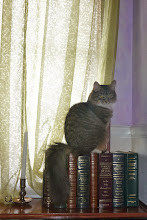















The original plan for the day was to go to Norwich Castle, but, as happens to most plans, that one got chucked out the window and saved for a later date. Instead, I met up with some of Kassy's (American flatmate) friends we went to Norwich Cathedral and explored town a bit.
The pictures, for some reason, are in reverse order--the first photo is at the bottom and the last photo is at the top.
First (bottom) is a picture of a typical city street in Norwich. The second is a courtyard with shops. Not only do they have shops on the streets, but then there are a plethora of little alleyways that you can duck into that lead to courtyards with more shops. The third and fourth photos are of Elm Street. Elm Street is a semi-famous street that, up until the Dutch Elm Disease of 1970, had elm trees that had been there since the reign of Henry VIII. The fifth photo features Tombland market, located in the center of old Norwich. The placard next to the market says Tombland market was "known in the 13th century as Tomeland, from the Old Norse 'tom' meaning 'open space'. It was the civic centre of Anglo-Scandinavian Norwich and the site of the pre-Norman market." Next we have the former entrance to Bridewell Prison, unassumingly wedged between two standard shops located on your average random side street. Bridewell was first built in 1325, housed the mayor of Norwich in 1404, and was turned into a prison from 1583-1828. The following two photos are of the courtyard adjoining St. Andrew's Cathedral. You can hardly turn around without bumping into some cathedral or another. St. Andrew's, St. John's, St. Julian's, and Norwich Cathedral are the most prominent ones, so far as I can see. You actually have to walk through the St. John's graveyard in order to get to the mall or the grocery store. But of course Norwich Cathedral is the crown jewel.
Norwich Cathedral (pictured next) has the second-highest spire in all of England. The tallest belongs to Salisbury Cathedral. Following, there are some pictures of the courtyard in the cloisters and the Jubilee Labyrinth in the middle of it. The Jubilee Labyrinth was set down in 2002 in celebration of the Golden Jubilee of Queen Elizabeth II. It's supposed to symbolize the spiritual journey through life. Next is a picture of the doorway leading from the cloisters to the nave. The most impressive things about Norwich Castle are actually the ceilings in the nave and cloisters, so I've dedicated the remaining pictures to them. First is the cloisters, then the nave, followed by a close-up of the ceiling. Each of those blobs is a carving, and each one is different. There are carvings of monks, of saints, of demons, of Christ in a variety of forms, carvings of shrubs and flowers, scenes from Revelations, and others. It's the same thing in the cloisters. I put up some photos of a couple of the carvings. The last photo, however, is the best. This is a photo of one of said carvings in the cloisters. It's known as the Green Man. The Green Man in Norwich is a particularly famous one, but Green Men do show up in other places. Peter Pan was partially inspired by the Green Man. It is thought to be a pagan nature deity associated with spring, inspiration, and rebirth. When Christian missionaries came to convert the locals, they would adopt and adapt local deities, turning them into obscure saints so as to make Christianity more palatable to the natives. Another tactic for conversion was mixing pagan deities with saints, telling the locals that the deity and the saint were one and the same. For example, Brigit, a Celtic triple goddess and daughter of the Dagda, was conflated with St. Brigid, and now both share the symbol of the sacred flame of Kildare. But to go back to the Green Man: the Green Man is thought to be the earlier form of the Green Knight in the famous medieval poem Sir Gawain and the Green Knight, and the sculpture of the Green Man at Norwich is sometimes put on the cover or frontispiece of Sir Gawain and the Green Knight books.
Better luck next time with the photos. Apologies for my lack of tech abilities!

I LOVE gothic architecture. Great pictures and explanations, even if it did require some scrolling up and down. It was totally worth it.
ReplyDelete